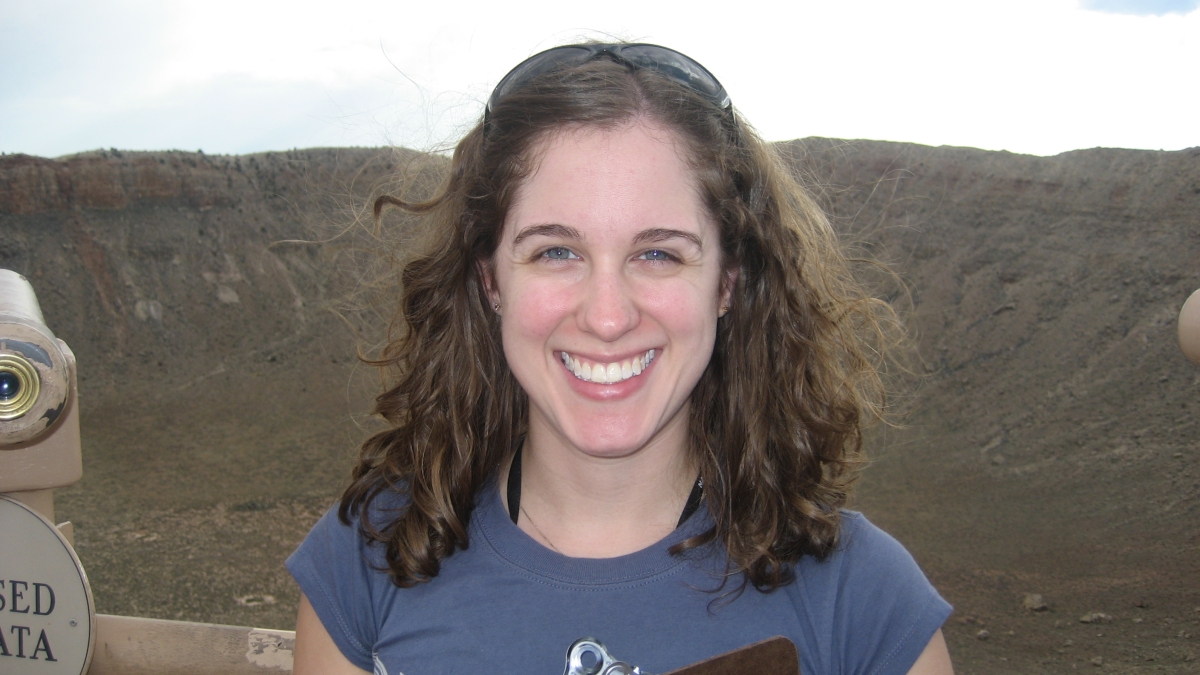Fourth PhD in family wears grandfather's doctoral regalia

Lillian Ostrach will follow a unique family tradition when she graduates with her doctoral degree in geological sciences from ASU’s School of Earth and Space Exploration (SESE).
She will be hooded while wearing her 90-year-old grandfather’s doctoral regalia during commencement ceremonies. Dr. Simon Ostrach will proudly watch as his granddaughter carries the College of Liberal Arts and Sciences gonfalon during opening ceremonies.
“I am the fourth person in my family to earn a PhD, and the first woman,” she says. “I was raised to value family and family traditions, and one tradition we have is that each PhD wears my grandfather’s doctoral regalia during the commencement ceremonies.”
The regalia was originally purchased in 1950 and worn by her grandfather when he earned a doctoral degree in applied mathematics, and then later worn by her father (neuroscience) and her uncle (comparative pathology).
Science seemed a natural path for Ostrach. “I have always had a love of the outdoors (especially rocks), and from an early age my parents and grandfather exposed me to science and math,” she says. “My father and grandfather both worked for NASA, so space exploration was a large part of my childhood, and I became fascinated (as many young children do) with the planets and workings of the solar system.”
Yet she didn't plan on becoming a geologist or planetary scientist until she took a few geology classes during her undergraduate studies at Brown University.
“I realized my passion. I really wanted to research landforms and geologic processes on other planets.”
After earning her bachelor’s and master’s degrees in geology, with a focus in planetary geoscience from Brown University, Ostrach decided to complete her doctorate at ASU.
“I was attracted to ASU because, out of all the programs in the country, SESE offered a multi-disciplinary approach to science education. SESE emphasizes collaborations, discussions and education across traditional field boundaries, and I embraced the potential for multi-disciplinary research.”
Ostrach’s research focuses on the impact cratering process, primarily on the moon and Mercury. She completed her investigations using recently acquired images from the Lunar Reconnaissance Orbiter (LRO, currently in orbit about the Moon) and the MErcury Surface, Space ENvironment, GEochemistry, and Ranging (MESSENGER, currently in orbit about Mercury) missions.
“Investigating the impact cratering process and the impact cratering record is integral to understanding early solar system history, including early Earth, and the geologic processes that shape the surfaces of rocky planets and icy satellites.”
Recognition of Ostrach’s talents has been extensive. She has presented at international conferences, including the Lunar and Planetary Science Conference in Houston, and received the ASU SESE Rock Star Geology Student Award in 2011, the SESE Graduate Student Merit Award in 2010, and received travel grants for field workshops and conferences. Participation in workshops and field camps enhanced her skills and knowledge in planetary volcanism and impact cratering.
As a scientist, she believes in the importance of outreach to make science more accessible to the public. As a woman in science, she wants to inspire young girls and young women to explore opportunities in STEM (science, technology, engineering and math) fields.
Volunteer and outreach activities have been frequent during her studies at ASU, including SESE open houses, the Phoenix Zoo Prowl and Play, Hands-On Science Days, guest lectures for groups and K-12 teacher workshops.
Ostrach will begin a postdoc fellowship at the NASA Goddard Spaceflight Facility in early January, where she will continue studies of the impact cratering process.
“I can expand a comparative planetology investigation included in my thesis to the global scale, in addition to beginning new projects with my new advisor and colleagues.”
Extracurricular activities include eclectic tastes, extending from being an avid reader of many genres to Broadway musicals, weight lifting, swimming, baking and crocheting. “However, if you asked my friends, they would all say that I’m a huge 'Doctor Who' fan.” The popular sci-fi television show inspired a collection of Doctor Who items that she owns or has made, and even a Doctor Who-themed wedding.
“Writing a dissertation is a lonely process,” she says, “but earning a PhD is essentially a group effort.” Ostrach mentions a very long list of people who provided help, friendship and guidance, including ASU staff, faculty, fellow graduate students and postdocs.
“A few key people must be named because they were instrumental along the path: my advisor, Dr. Mark Robinson, who taught me how to be a better scientist; my parents, who prompted me to follow my dreams no matter how far away or 'out there'; my sister Sarah, who supported me through the good, bad and ugly of graduate school; my husband Jack, who waited for me for eight long years of long-distance; and lastly, my Grandpa, who inspired me to follow a path of my choosing.”